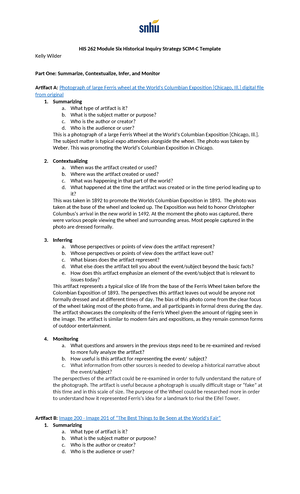- Information
- AI Chat
Was this document helpful?
HIS 262 Module Six Historical Inquiry Strategy SCIM-C Template
Course: HIstory (262)
64 Documents
Students shared 64 documents in this course
University: Southern New Hampshire University
Was this document helpful?

HIS 262 Module Six Historical Inquiry Strategy SCIM-C Template
Part One: Summarize, Contextualize, Infer, and Monitor
Artifact A: Photograph of large Ferris wheel at the World's Columbian Exposition [Chicago, Ill.] digital file
from original
1. Summarizing
a. What type of artifact is it?
b. What is the subject matter or purpose?
c. Who is the author or creator?
d. Who is the audience or user?
This photograph captures a spacious Ferris Wheel at the World's Columbian Exposition in
Chicago, Illinois. It showcases typical expo attendees alongside the wheel. The image, credited
to Weber, served as a promotion for the World's Columbian Exposition in Chicago.
2. Contextualizing
a. When was the artifact created or used?
b. Where was the artifact created or used?
c. What was happening in that part of the world?
d. What happened at the time the artifact was created or in the period leading up to it?
Captured in 1892 to advertise the upcoming World's Columbian Exposition in 1893, this photo
was taken from the base of the Ferris wheel, looking upward. The exposition commemorated
Christopher Columbus's arrival in the New World in 1492. At the time of the photograph,
numerous individuals were observing the wheel and its surroundings. The majority of people
depicted in the photo are dressed in formal attire.
3. Inferring
a. Whose perspectives or points of view does the artifact represent?
b. Whose perspectives or points of view does the artifact leave out?
c. What biases does the artifact represent?
d. What else does the artifact tell you about the event/subject beyond the basic facts?
e. How does this artifact emphasize an element of the event/subject that is relevant to
issues today?
This artifact offers a glimpse into daily life at the base of the Ferris wheel before the Columbian
Exposition of 1893. However, it presents a limited perspective by excluding individuals not
attired formally and scenes from different times of the day. The bias of this photo is evident in
its clear focus on the wheel, which dominates most of the frame, and the participants uniformly
dressed in formal attire during daylight hours. Despite these limitations, the artifact highlights
the intricate structure of the Ferris wheel, evident from the visible rigging in the image.
Moreover, it resonates with modern fairs and expositions, which continue to serve as popular
outdoor entertainment venues.
4. Monitoring
a. What questions and answers in the previous steps need to be re-examined and revised
to more fully analyze the artifact?
b. How useful is this artifact for representing the event/ subject?
c. What information from other sources is needed to develop a historical narrative about
the event/subject?
Revisiting the artifact's perspective could provide deeper insights into the photograph's essence.
Its value lies in the inherent difficulty of staging or falsifying a photograph of this size and era.
Further research into the wheel's purpose could unveil how it embodied Ferris's vision for a
monumental landmark.
Artifact B: Image 200 - Image 201 of “The Best Things to Be Seen at the World's Fair”
1. Summarizing
a. What type of artifact is it?
b. What is the subject matter or purpose?







